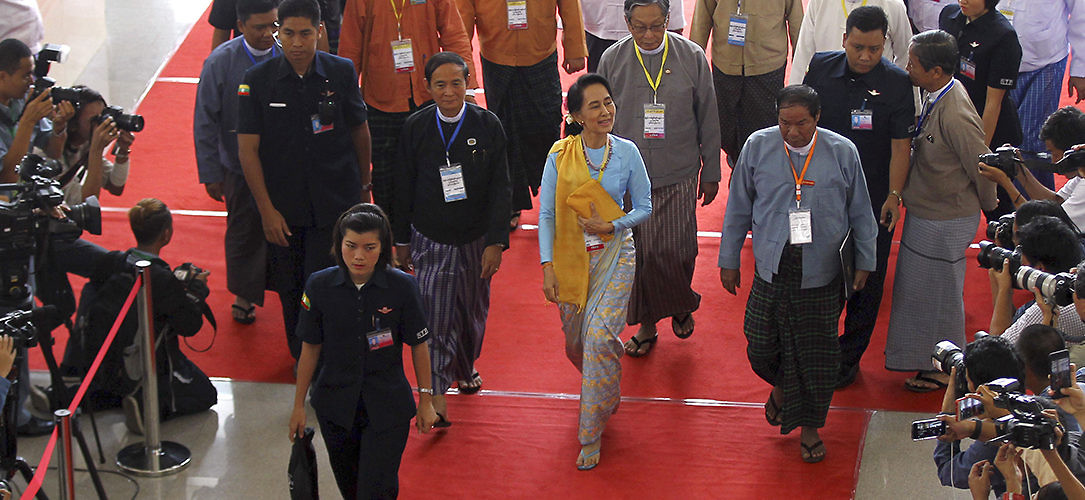Myanmar State Counsellor Aung San Suu Kyi arrives at the second session of the 21st Century Panglong conference. Naypyitaw, Myanmar, May 24, 2017 (Aung Shine Oo/Associated Press)
Even before the elections of November 2015, there was a general foreign perception that Myanmar was on the “road to democracy.” But the military only promised a “discipline-flourishing” democracy—and whenever that term is modified, it is diminished. Myanmar is definitely on a transitional path from which there is no returning to authoritarian rule without widespread public disturbance. But after one year there are questions over where it is going, how fast, and the myriad potholes in the road ahead.
Elections ideally allow the peaceful transfer of power between parties and are one critical hallmark of democracy—but not the only one. Indeed, the peaceful transfer of power in Myanmar from a military-backed party to the civilian National League for Democracy (NLD) in 2015 masks something far more complicated. There has been neither a peaceful transfer of power to the new government nor the complete retention of power by the military.
The 2015 elections have not resulted in military–civilian compromise. The military under the 2008 constitution has carefully designed a system of control over those elements it regards as essential to the state’s wellbeing and its own position. It refuses to amend the constitution to diminish its control over three key ministries—defense, home affairs, and border and minority issues—that encompass all elements of state coercion and bureaucratic administration.
The military also retains control over the most enduring and salient issue that has faced the state since independence: the distribution of power and resources among the minority ethnic peoples and the majority Burman Buddhists. The military can prevent amendments to the constitution and legally declare martial law if it believes the situation warrants it. There is no need for a military coup, as some outsiders fear. The military still has the constitutional power to rule should it determine conditions require it.
The military’s primary objectives since independence in 1947 have been national unity and the autonomy of the military from civilian political control.
Rather than ameliorating distrust and divisions, Aung San Suu Kyi and her NLD have tried to outflank the military by creating their own trans-ministerial position of state counsellor, setting up a separate ministry dealing with minority affairs and ensuring that formal international affairs are in Suu Kyi’s hands as Foreign Minister.
In this supposedly “fusion” government—in which the gears do not completely mesh— essential trust is lacking on both sides. There is mistrust among and between Myanmar’s various ethnic groups as well as towards the military and the NLD. Suu Kyi’s first year has not diminished suspicions.
The results of the 2015 election created immediate euphoria internally and internationally, and unrealistic expectations of quick economic and socio-political improvements that could never be easily attained. Ironically, stronger democratic mechanisms in the legislature, a freer media and more open public discourse have only made socioeconomic change more difficult amid pervasive rising nationalism—both among the majority Burmans (Bamah) and the ethnic groups.
Across Myanmar’s history, personalized power has been the norm. Loyalty is to the leader, not to the institution, and when key officials are chosen today they are described as loyal to an individual, not an institution or ideal.
This has important implications both for democratic governance and the implementation of reforms. Decisions made only at the top constipate change. Compromise is difficult and delegation of authority becomes a problem because delegation is a zero-sum game. Reliance is on loyalty rather than law.
So the gears of government are grinding because of personal differences as much as institutional ones. Aung San Suu Kyi and General Min Aung Hlaing’s relationship is said to be formal but distant, and trust is obviously lacking.
The solution to the minority issue is Aung San Suu Kyi’s stated primary objective—the “peace process.” This, the most important issue facing the state since independence, remains unsolved. It is Suu Kyi’s primary objective not only because of national need, but because her father organized the first Panglong (minority) conference on February 12, 1947 (still the National Day holiday). Suu Kyi organized the second such meeting in August 2016 and another for this month. These meetings have yet to address the salient politico-economic and military issues and so far have excluded some ethnic groups. Prospects are not bright over the near term.
Aung San Suu Kyi says she is a politician, not a democratic idol. Yet her actions or lack thereof indicate that she has a limited understanding of the nature of politics and the public’s expectations of politicians.
Suu Kyi’s overt popular influence is manifest, but she has also had immense external influence, effectively controlling US policy towards Myanmar during the Clinton and Bush presidencies. Yet she discusses human rights in platitudes, and there is widespread foreign disappointment in her reluctance to question the military, Muslim oppression, and the burning issue of the Rohingya.
Perhaps the military is awaiting the 2020 elections when, disappointed with the accomplishments of the NLD government, a revitalized military may believe it can regain political control with, perhaps, Min Aung Hlaing as leader.
This is not to predict that an unmodified democracy will not eventually come to Myanmar. But the West tends to be impatient, and in the case of Myanmar patience is needed, along with continuous but quiet commitment and realistic expectations.
David I. Steinberg is Distinguished Professor of Asian Studies Emeritus, Georgetown University. This article originally appeared on East Asia Forum. It has been edited slightly for style.





